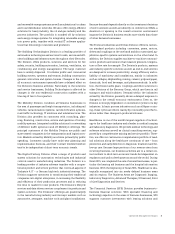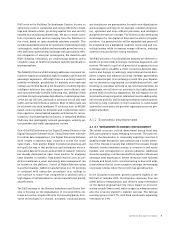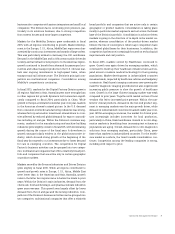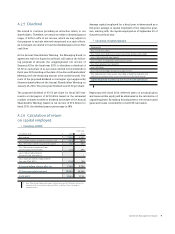Siemens 2015 Annual Report Download - page 8
Download and view the complete annual report
Please find page 8 of the 2015 Siemens annual report below. You can navigate through the pages in the report by either clicking on the pages listed below, or by using the keyword search tool below to find specific information within the annual report.Combined Management Report
The U. S. economy experienced a slowdown during the start of
the year as a result of a harsh winter and disruptions caused by
port strikes. The acceleration in the succeeding quarters
showed that the underlying recovery trend was intact, mainly
because of strong domestic demand. In particular, fixed invest-
ments performed better than the overall economy, although
capital expenditures related to oil and gas production declined
significantly due to lower oil prices. Strong consumption ex-
penditures were fueled by a steadily improving labor market.
All in all the negative effects outweighed the positive ones,
leading to declining worldwide gross domestic product (GDP)
forecasts for in the course of the year, down to . %
growth from . % expected in October . Fixed investments
are forecast to expand by . % in calendar , down from
. % expected in October .
The partly estimated figures presented here for GDP and fixed
investments are calculated by Siemens based on an IHS Global
Insight report dated October , .
A.1.2.2 MARKET DEVELOPMENT
The markets of the Power and Gas Division remained challeng-
ing in fiscal . This was particularly evident in the market for
steam turbines where volume shrank substantially year-over-
year due including to an ongoing shift from coal-fired to gas-
fired power generation in the U. S. and emission regulation e. g.
in China. Demand in compression markets declined year-over-
year. This was due mainly to a fall in capital expenditure for oil
and gas upstream applications following the global oil price
decline in . In contrast, demand in the gas turbine market
grew in fiscal , driven by demand for replacement of aged
existing inefficient and inflexible power plants, particularly
in the U. S.; energy market reform in Mexico; and rising de-
mand for energy in emerging countries, particularly China and
countries in Latin America and the Middle East. The Division’s
competition consists mainly of two groups: a relatively small
number of equipment manufacturers, some with very strong
positions in their domestic markets, and on the other hand a
large number of engineering, procurement and construction
contractors. The gas turbine market is experiencing overcapac-
ity among original equipment manufacturers and engineering,
procurement and construction contractors, which is leading to
market consolidation.
Markets served by the Wind Power and Renewables Division
grew moderately in fiscal . Overall growth was driven by
the onshore wind power market segment, while the relatively
smaller offshore wind power market segment saw a slight de-
cline year-over-year. On a geographic basis, growth was strong
in China, which has the largest national wind market in the
world, but where market access for foreign manufacturers
remains difficult. Policy and regulatory frameworks continue to
influence regional wind power markets. For example, the pro-
duction tax credit remained pertinent for the U. S. market. In
Germany, the scheduled expiration of feed-in-tariffs beginning
with calendar for newly build onshore wind power plants
fueled demand in fiscal . Market growth also benefited
from stronger demand from some emerging countries in the
Middle East, in Africa and Latin America. The competitive situ-
ation in wind power differs in the two major market segments.
In the markets for onshore wind farms, competition is widely
dispersed without any one company holding a dominant share
of the market. In contrast, markets for offshore wind farms con-
tinue to be dominated by a few experienced market players.
Consolidation is moving forward in both on- and offshore seg-
ments, including exits of smaller players. The key drivers of
consolidation are technology challenges and market access
challenges, which increase development costs and the impor-
tance of risk sharing in offshore wind power.
In fiscal , markets for the Energy Management Division
saw demand growth overall. The utilities market, the Division’s
most important customer segment, showed moderate growth.
There was also stronger demand from the chemicals, metals
and construction industries year-over-year. Within the chemi-
cals industry, drivers of growth were sustainability and energy
efficiency. In the Americas, growth in the chemicals industry
benefited from process industries, which showed a trend to-
wards re-industrialization in the U. S. and a build-up of capac-
ities within the region overall. Within the metals markets,
demand was held back by continued overcapacities and re-
duced investment activity, particularly in the region Europe,
C. I. S., Africa, Middle East. Construction markets grew in all
regions. In contrast, demand in the Division’s oil and gas and
minerals and mining markets declined year-over-year. The oil
and gas industry has significantly reduced capital expenditures
due to the global oil price decline. The minerals and mining
industry suffers from lower demand for raw materials, mainly
driven by the economic slowdown in China, and also by over-
capacities and higher extraction costs. Competitors of the
Energy Management Division consist mainly of a small number
of large multinational companies. International competition is
increasing from manufacturers in emerging countries such as
China, India and Korea.
Markets for the Building Technologies Division grew moder-
ately in fiscal . Growth was driven by rising demand from
the U. S. and Asia, despite weaker growth in China. Within the
Europe, C. I. S., Africa, Middle East region, markets in the Middle
East grew stronger than the region overall. The European mar-
ket grew modestly with growth in Germany, the U. K., and Scan-
dinavian countries above average. The Division’s principal com-
petitors are multinational companies. Its solutions and services





















